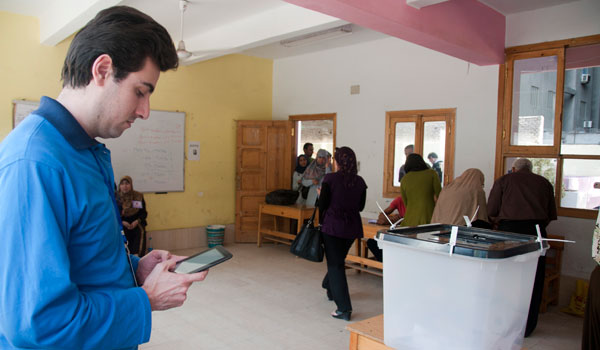The Carter Center is pioneering new technology that allows observations from polling stations across a country to be transmitted to headquarters immediately, allowing a richer picture of an election to emerge in real time – key to being able to determine quicker if an election is credible.
As the international community looks to observer organizations to determine if elections in highly contested, tense environments can be trusted, such quick analysis is key.

Field Office Director Sanne van den Bergh and the Carters enter their findings into a tablet at a Cairo polling station on May 24, 2012. The new technology allows observations from polling stations across a country to be transmitted to headquarters immediately, allowing a richer picture of an election to emerge in real time. (Photos: D. Hakes/The Carter Center)
“This new technology takes us to the next step of election observation,” said David Carroll, director of the Carter Center’s Democracy Program. “The scope of data that we can meaningfully analyze quickly has exponentially increased.”
Each team of election monitors is issued a handheld tablet that runs an open-source data collection application called Open Data Kit, developed at the University of Washington.

Carter Center observer Haissam Minkara prepares to use a tablet to enter his findings at a polling station in Cairo in May 2012. Monitors take detailed notes using the tablets at each polling station they visit and send it back to Carter Center headquarters – information such as if the polling station opened on time, if the station has all needed materials for voting and counting, if there is illegal campaigning outside a station, and if voters are being intimidated in any way.
The monitors take detailed notes using the tablets at each polling station they visit on election day and send it back to Carter Center headquarters – information such as if the polling station opened on time, if the station has all needed materials for voting and counting, if there is illegal campaigning outside a station, and if voters are being intimidated in any way.
“I did a better job observing because of this technology,” said Charlotte McDowell, an OAS staff member serving as an observer for The Carter Center during Egypt’s presidential election in May 2012. “Knowing that we will be able to analyze large amounts of data quickly made me put more time and details into my observations and ensuring I sent them quickly and correctly. I knew they were a valuable contribution.”

Carter Center observer Haissam Minkara uses a tablet to enter his findings at a polling station in Cairo in May 2012. His notes were transmitted immediately to the Center’s headquarters in Cairo, where team members use ELMO, an application developed by The Carter Center, to collect, review, and analyze all the information as it arrives throughout the day.
Back at headquarters, core team members use ELMO, an application developed by The Carter Center, to collect, review, and analyze all the information from observers as it arrives throughout the day. This project builds on a previous Carter Center project with Georgia Tech to use smart phones in election observation.
“This technology is a big improvement over older paper-based systems in which aggregated summaries were communicated by phone at the election’s conclusion,” said Avery Davis Roberts, assistant director of the Carter Center’s Democracy Program. “This method provides up-to-the-minute information for our leadership as meetings are conducted and the mission statement is drafted.”
In the future, the Center expects to further integrate this technology into its election monitoring efforts including long-term reporting, domestic observation, and mapping/geographic information systems.
Please sign up below for important news about the work of The Carter Center and special event invitations.